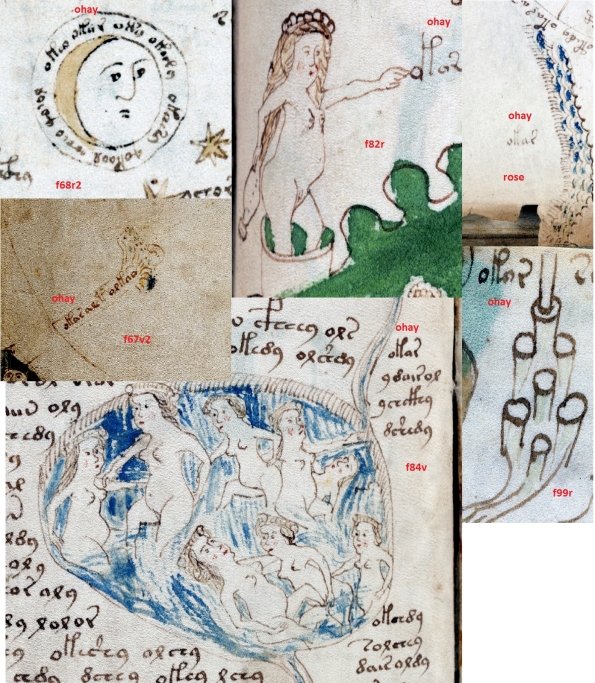Archive
Naked Ladies
I have been trying to make sense of the labels on the ladies in the bathing section. Here is a graphic extract of the folios that show the sets of the ladies where each has a label:
(Full detail here: http://pcbunn.cacr.caltech.edu/voynich/ladies_labels.png beware .. about 20MB)
The reasonable assumption is that the labels are the names of each lady. The labels tend to be short, whereas typical female European names of the 15th Century tend to be rather long: see for example the lists at http://www.s-gabriel.org/names/
Most female Italian names from that period end in “a”. So one might expect some similar common feature amongst the labels … But there is nothing apparent, except perhaps for the somewhat common terminal “9”.
What else could the labels be, if not names?
Also, the ladies are predominantly naked, with few exceptions. The lady labelled oeh9 on the top row in the graphic appears to have a red striped shawl around her shoulders, but she is visibly naked beneath. This strikes me as odd … as she is so distinct, perhaps she can be identified historically by this pattern (I’m looking at R.Sale!)?
Some of the ladies have long hair, some short. Nothing odd about that, but the ones with long hair sometimes appear to be wearing some sort of crown – see for example lady ogoy next to the shawled lady in the top row, and lady sohoe9 in the lower middle of the graphic: she is also holding some sort of ring or handle.
As regards the labels, the most plausible hypothesis is that they are codes for names. My preference for them being names is that it’s the simplest explanation.
Perhaps the whole book is a local guide – the plants from the region, the stars that can be seen from the region, the local spa and slime facilities, the local recipes (but no hedgehogs, please), and featuring the local “talent” – the beautiful ladies who live there. It’s a tourist guide, if you like. Perhaps the information it contains was quite scandalous for the times, hence the code.
“ohay” … Oh, hai!
T/O Maps, the Moon and Carthage
Consider the three T/O maps (thanks to Rich Santa Coloma for this suggestion), depicting the Earth (or World) in the VMs (on f67v2, the Rosettes, and f68v3). Looking at f67v2 there is a channel between the moon and one of the T/O map quadrants, labeled “ohay aeck oehaN”. The same quadrant is labelled “ohay” on the Rosettes. It makes sense that the Earth is shown like this on both folios – away and to the side – as these folios are dedicated to illustrations of the sun, moon etc. and (perhaps) paradise or the garden of earthly delights, respectively. Let’s come back to this later – specifically the significance of the label “ohay” with the Moon. 

The T/O map on f68v3 can be compared with a map from 1472 , and it’s tempting to match “oko8oe” to “Africa” or “Cham”.
However, the Asia part of the map on f68v3 is labeled with a set of words, rather than a single word that might be “Asia” or “Sem”. So perhaps this is a list of prominent place names in Asia. Perhaps the labels on the Europa and Africa quadrants are also prominent place names? Here’s a contemporary map that shows Africa, Europa and Asia (from 1483):
In Africa, we see the city of Cartha (Carthage). Carthage is even more prominent in this map dating from 1110:
So, the conjecture for this T/O map on f68v3 is that it is showing prominent (or significant) place names in each continent, and that “oko8oe” = “cartago”. This fits nicely (of course) with the “ok-” = “ca-” prefix theory.




